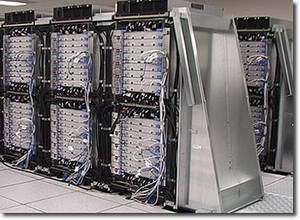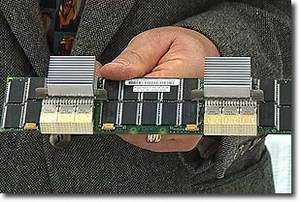NNSA/LLNL supercomputer breaks computing record: exceeds 100 teraflops

National Nuclear Security Administration (NNSA) Administrator Linton F. Brooks announced today that a supercomputer developed through the Advanced Simulation and Computing program for NNSA’s Stockpile Stewardship efforts has performed 135.3 trillion floating point operations per second (teraflops) on the industry standard LINPACK benchmark, making it the fastest supercomputer in the world.
By performing computations at these rates, BlueGene/L helps maintain the U.S. nuclear weapons stockpile without nuclear testing.
Image: To provide cooling for BlueGene/L, designers came up with this innovative slanted edge, allowing refrigerated air to circulate more efficiently through the computer's racks.
This performance was achieved at Lawrence Livermore National Laboratory (LLNL) at only the half-system point of the IBM BlueGene/L installation. Last November, just one-quarter of BlueGene/L topped the TOP500 List of the world’s top supercomputers.
“Blue Gene/ L will address vital challenges critical to ensuring the safety and reliability of the nation’s aging nuclear weapon stockpile,” said Administrator Brooks. “This supercomputer provides an essential resource to the weapons complex, allowing us to address time-urgent and mission-critical scientific issues that require such specialized computational capabilities.”
Results of scientific importance have already been accomplished with only one-quarter of BlueGene/L. Scientists at LLNL for the first time have performed 16-million-atom molecular dynamics simulations with the highest accuracy inter-atomic potentials necessary to resolve the key physical effects to successfully model pressure induced rapid resolidification in Tantalum. As a shared resource, BlueGene/L has enabled scientists studying the effects of voids in metal failure at Los Alamos National Laboratory to perform standard accuracy molecular dynamics simulations with more than 2.1 billion atoms.
“BlueGene/L’s latest accomplishment is an important step toward achieving the capabilities we need to succeed in our stockpile stewardship mission,” said Michael Anastasio, LLNL’s Director. “BlueGene/L allows us to address computationally taxing stockpile science issues at very low cost. Effective and relatively inexpensive supercomputers of this nature will open doors for scientists across the country.”

Image above: The unique BlueGene/L "compute card" consists of two nodes, each containing two central processing units (CPUs) including four megabytes of dedicated memory. Also mounted on the circuit board are a memory controller module and nine separate memory chips, similar to those in standard home and office desktop computers.
“This milestone demonstrates our continued commitment to revolutionize the way supercomputers are built and to broaden the kinds of innovative applications we can run on them,” said Nick Donofrio, senior vice president of technology and manufacturing at IBM. “BlueGene/L’s record-setting performance underscores the power of open standards and collaboration in driving true, meaningful innovation that benefits society.”
Established by Congress in 2000, NNSA is a semi-autonomous agency within the U.S. Department of Energy responsible for maintaining and enhancing the safety, security, reliability and performance of the U.S. nuclear weapons stockpile without nuclear testing; working to reduce global danger from weapons of mass destruction; providing the U.S. Navy with safe and effective nuclear propulsion; and responding to nuclear and radiological emergencies in the United States and abroad.
Founded in 1952, Lawrence Livermore National Laboratory has a mission to ensure national security and to apply science and technology to the important issues of our time. Lawrence Livermore National Laboratory is managed for NNSA by the University of California.
Source: Lawrence Livermore National Laboratory


















